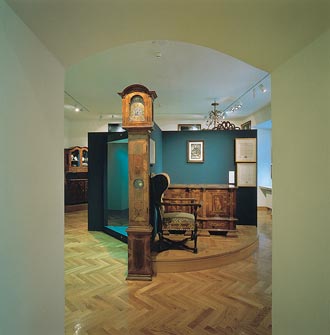Permanent Display 24. Magnates at Gradec
 Sessions of Parliament, and the frequent comings of the members, gentry and aristocrats, and the end of the great war in 1699 all resulted in Gradec becoming the residence of the upper classes.
Sessions of Parliament, and the frequent comings of the members, gentry and aristocrats, and the end of the great war in 1699 all resulted in Gradec becoming the residence of the upper classes.
In the central square the noble mansions of Ban Petar Zrinski, near the Puskarnicza or city armoury, and of Ban Nikola Erdödy were built. In the aristocratic houses, as in those of the middle classes, the living conditions were still quite modest, as compared with those in the country houses. It was only in the mid-18th century that the magnates began to build their palaces on the big plots round the perimeter, changing the picture of the Upper Town as Gradec was then often called.
From the war that had been waged all round Europe, back came the magnates with well-earned promotions and with new ideas and a new life-style. While they were occupied with carrying out their duties at court, in the county and in the Parliament, their wives were thrifty housewives, and their sons were at school at the Theresianum. Proper behaviour was learned reading (in Kaikavian) the School of Christ, the catechism of Abbot Juraj Mulih, to which the author had added some rules for everyday life in this world.
 The novitas novitatum of social life was the abundance of dances and entertainments, especially during carnival time, and the marriage intrigues that linked the Sermage, Oršić, Rauch and Kulmer families.
The novitas novitatum of social life was the abundance of dances and entertainments, especially during carnival time, and the marriage intrigues that linked the Sermage, Oršić, Rauch and Kulmer families.
All these events were noted, with no criticism spared, by Canon Adam Baltazar Krčelić, chronicler of Zagreb life during the period between 1748 and 1767. He noted as being very important the first exhibition of paintings of a “satirical nature” that was put on in 1754 by Antun Janković.
Moving into aristocratic circles with the purchase of a count’s title, in 1764, Žigmund Vojković built Gradec’s most luxurious palace. Here he gathered the society in the great central hall of the palace, in which theatrical performances were given, the actors being members of the distinguished families.
The popularity of theatrical performances drew travelling German troupes to Zagreb. In 1797 the first public Town Theatre started up. For almost four decades many performances were given in the great theatre hall, which the owner of the palace, Count Amade, leased out.
Željka Kolveshi

